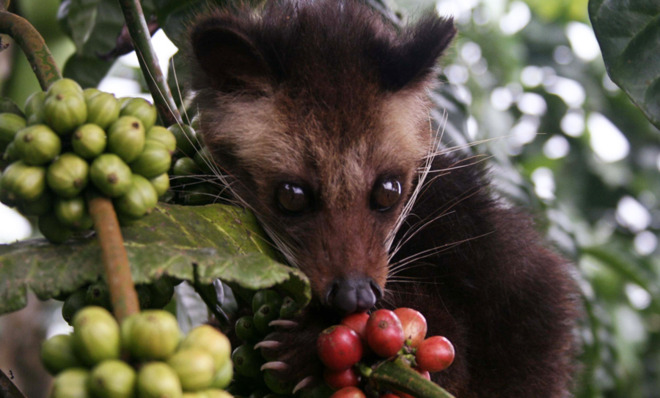How animal poop becomes fancy coffee
In the foggy hills of the northern Philippines, committed and courageous harvesters reach into the unlikeliest of places to produce some of the world’s most coveted coffee


Civets — furry, weasel-like creatures with pointy noses and a love of frolicking over rocks and up and down trees — have long been valued for their excretions. African civets were the original source of perfume musk, scraped from the skin of living civets or squeezed from the glands of dead ones. In India today, as in ages past, the oil extracted from pieces of their meat is still used as an indigenous cure for scabies. In Southeast Asia, civets shit gold.
More precisely, on a gram-per-gram basis, the coffee beans found in civet shit are worth roughly twice that of silver.
It is literally shit — it comes out brown and in a tubular shape. Its texture and contents vary depending on what the civet may have been eating. Like any shit, we could be flushing it down the toilet or cursing every time we step in it. We could choose to find it dirty and worthless. But, no. When it comes from a civet, we prize it.
The Week
Escape your echo chamber. Get the facts behind the news, plus analysis from multiple perspectives.

Sign up for The Week's Free Newsletters
From our morning news briefing to a weekly Good News Newsletter, get the best of The Week delivered directly to your inbox.
From our morning news briefing to a weekly Good News Newsletter, get the best of The Week delivered directly to your inbox.
At Dean and Deluca in Manhattan, fifty grams of civet coffee goes for $60. For the equivalent price of a kilo of the coffee, about two pounds, you could get a Marsèll bi-fold, crocodile skin wallet with a leather interior, a snap-close coin compartment, two billfold pockets and six card slots. Or a pair of hot pink, four-inch Christian Louboutin patent leather heels covered in tonal spikes.
Drink it — it's shit. (No, really.)
Twenty-thousand square feet brimming with writers, filmmakers, designers and disruptors. What's not to love?
I decided to go find out what makes their shit so special.
A free daily email with the biggest news stories of the day – and the best features from TheWeek.com
(More from Narratively: Secrets of a die-hard ventriloquist)
Coffee grows where it's cold and high, places like the bucolic mountaintop village of Sagada, 14 hours north of Manila. To get there, I took a bus to Baguio, the largest city in the Cordilliera mountain range, where I spent the night in a grimy roadside traveler's hotel. Waking up early the next morning, I caught another, older bus, and took a nauseating, air-condition-less ride up an exceedingly steep and winding mountain range.
The view through the window was frightening and spectacular. Pine trees disappeared into the clouds. The side of the mountain plummeted. Houses were fixed to the earth in some places and, in others, floated above it on stilts. It is a place where villagers farm cabbage and corn out of carved-out mountain terraces and the world looks like an old topographical map.
After I got to town I still had to take an hour-long hike through a muddy jungle to get to the coffee plantation, with much sweating and stripping off of layers that had earlier on seemed so sensible in the thick morning fog. My guides, two native Igorot named Lambert and Masli, scampered up and down the wet slopes foraging ferns for dinner. I trailed behind them, more than once slipping onto my ass.
Up on the slope, nestled between towering limestone cliffs and a small rushing river, we found a scattering of coffee trees. There wasn't the ordered tidiness of other agriculture. Low and shiny, with elegant leaves, they were dispersed through the jungle growth, shaded by wide-leafed banana trees. Turquoise and black butterflies flitted about.
(More from Narratively: The spontaneous world of a Roman street circus)
This is paradise to the civet: virgin growth jungle with food to eat and a limestone jungle gym. I hoped to look up and see the bushy shadow of one of them, darting up the side of a cliff and into a little cave. Maybe it would peek out and wiggle its little nose before curling up for a nap against the cave wall, snout tucked into compact paws.
But that was never going to happen. In the five years that my guide Lambert has been harvesting civet droppings, he has never laid eyes on the beast. They're nocturnal. Shy, he says. They can hear you coming a mile away.
But Lambert has learned a surprising amount about civets. From observing the way they poop, he knows that they are creatures of habit. He knows that civets start frequenting the coffee farm around November, when green coffee berries begin to ripen into bright red grape-sized fruits. He knows that they a pick a path to get there — one they will take for the next several months, leaving a predictable trail of poop in their wake.
Early in the season, civets eat other fruits and meat on the way to the coffee farm. Lambert admits in Tagalog, his third or fourth language, that the smell is "kadiri," or disgusting. But after a couple of weeks, he says, when the civet has been munching almost exclusively on ripe coffee berries, the odor neutralizes, smelling more like dirt and dry leaves.
(More from Narratively: Saying I do, and saying farewell)
Harvesting civet droppings hasn't been easy for people like Lambert. When he first started out, his father, a schoolteacher, wasn't sure there was any money in harvesting coffee. He was understandably skeptical about his son's plan to go around looking for shit, picking it up and putting it in his backpack.
The job, rather unsurprisingly, is also a surefire way to get teased by friends. But Lambert says he doesn't care.
"I ignore them," he says, "because I know the price."
On a good day, with six hour's work at the height of the season, Lambert says he is able to harvest a full kilo of civet droppings. Depending on the quality of the product (some poop is better than other poop) and the vicissitudes of coffee market, that kilo could fetch him between 450 and 1,000 pesos — about $10 to $25, or two to five times the daily agricultural minimum wage in the mountains.
During the season, it adds nicely to the income of the family. Lambert splits his earnings with his mother, who runs a business selling secondhand clothes, and no one can argue with the money, whatever its origin. His father has come around. Lambert knows he's been telling other tribesmen to stop hunting and eating civets, because dead civets don't poop.
Read the rest of this story at Narratively.
Narratively is an online magazine devoted to original, in-depth and untold stories. Each week, Narratively explores a different theme and publishes just one story a day. It was one of TIME's 50 Best Websites of 2013.
-
 The best homes of the year
The best homes of the yearFeature Featuring a former helicopter engine repair workshop in Washington, D.C. and high-rise living in San Francisco
-
 Critics’ choice: The year’s top 10 movies
Critics’ choice: The year’s top 10 moviesFeature ‘One Battle After Another’ and ‘It Was Just an Accident’ stand out
-
 The small Caribbean island courting crypto billions
The small Caribbean island courting crypto billionsUnder the Radar Crypto mogul Olivier Janssens plans to create a libertarian utopia on Nevis